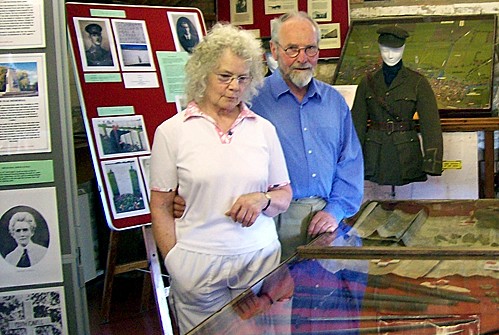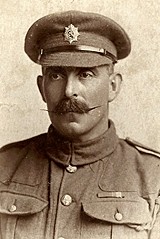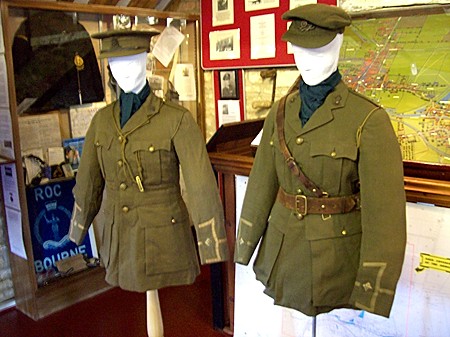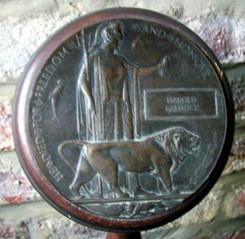The
World War One exhibition
HERITAGE CENTRE - July 26th until August 31st 2014
by REX NEEDLE

Jim and Brenda
Jones with some of the exhibits
|
AN EXHIBITION MARKING the centenary of the outbreak of the First World War on 4th August 1914 was staged at the Heritage Centre in South Street, Bourne during the summer of 2014. The display was organised by the Civic Society and included a wide variety of documents and artefacts relating to the conflict in which an estimated 250 men from the town took part. They served mainly with the Lincolnshire Regiment and other infantry units, but also in the cavalry and the guards, the Machine Gun Corps, the Royal Field Artillery, the Tank Corps, medical and ambulance units, the Royal Navy and the Royal Flying Corps. More than half of the men did not come back. The War Memorial in South Street records the names of 97 men who died in action although recent research has established that 37 names were missed off when it was erected in 1956 and so the total from Bourne who made the supreme sacrifice was 134. The exhibition had been assembled by members of the Civic Society which runs the Heritage Centre and was officially opened by the Mayor of Bourne, Councillor Bob Russell on the afternoon of Saturday 26th July. The society’s chairman, Mrs Brenda Jones, and her husband Jim, a committee member, organised the displays with the help of Doug Fownes and Bill Peasley. They spent several weeks scouring the town for mementos of the war and assembled an impressive collection of two army officers’ uniforms from Mrs Rosie Cudmore, an array of bayonets, badges and bullets from local military historian Tony Stubbs, medals, maps, photographs and other items from families with relatives who served including a bugle on which the last charge is reputed to have been sounded during the Battle of the Somme in 1916. Among the exhibits was a bronze next of kin plaque which was sent to the parents of Harold Baldock, a boy seaman who died at the age of 17 when his ship exploded in the harbour at Cromarty in Scotland, causing the death of 405 men out of a complement of 704. Ironically, he was the son of miller Frank Baldock and lived at Baldock’s Mill where the exhibition was held. There was also a rare photograph showing the first fifteen volunteers from Bourne to enlist for military service who left to join the Lincolnshire Regiment on Monday 31st August 1914. The company met at the recruiting depot in West Street and were escorted to the railway station by the town's brass band with a large number of residents following behind to give them a hearty send-off. The display boards also contained portraits and brief biographies of several men who saw active service including old soldier Charles Stuffins of Woodview, Bourne, who had already served in the Boer War of 1899-1902 but re-enlisted when the Great War broke out in 1914. He was sent to France where he was reported missing in action during the Battle of Cambrai in 1917 but survived and eventually won the Military Medal for bravery in action and after returning home to civilian life, died in 1954, aged 77. One of the displays also recorded the major contribution made to the war effort by the town of Bourne through the establishment of a military hospital which operated from the Vestry Hall in North Street throughout the war, staffed by doctors and Red Cross nurses recruited locally and which treated more than 900 injured soldiers from the outbreak in August 1914 to the Armistice in November 1918. The entire collection reflected a dark period in the history of this town and indeed the country but one that should not be forgotten and was regarded as a memorial to those who gave their lives in battle and the parents, wives, sweethearts, friends and relatives, who stayed behind to face the daily agony of waiting for news from the front. The exhibition remained open each day from 2 pm to 4 pm until Sunday 31st August and admission was free. |



